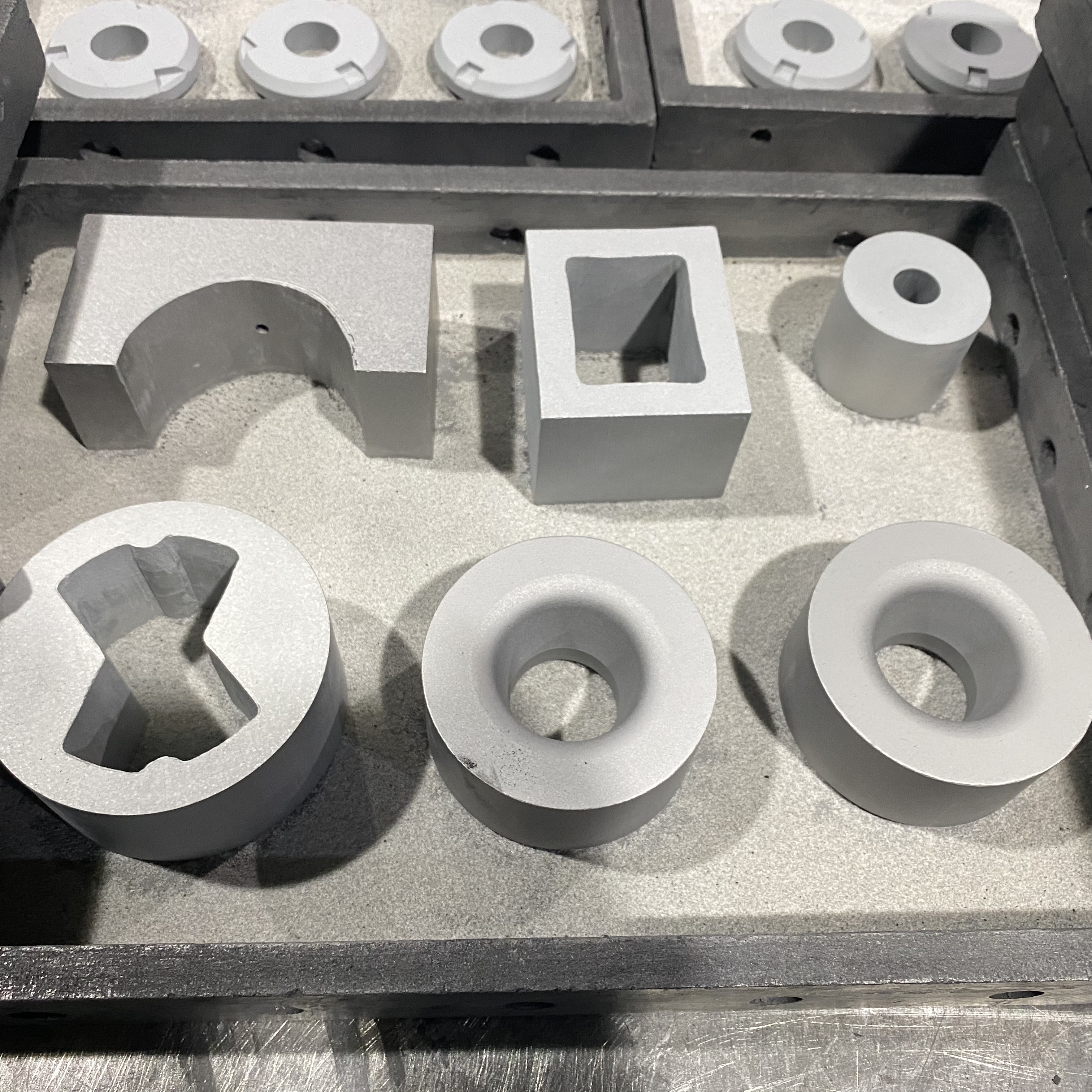Cemented carbide workpieces can be molded using a variety of processes. Depending on the size and complexity of the part and the production batch, most cutting inserts are molded using top and bottom pressed rigid dies. In order to maintain consistent workpiece weight and dimensions, it is important to ensure that the amount of powder (mass and volume) flowing into the cavity is identical for each press run. The flow of the powder is controlled mainly by the size distribution of the agglomerates and the properties of the organic binding agent. Molded parts (or “blanks”) are formed by applying a molding pressure of 10-80 ksi (thousand pounds per square foot) to the powder loaded into the mold cavity. Even at very high molding pressures, the hard tungsten carbide particles do not deform or break, but the organic bonding agent is pressed into the gaps between the tungsten carbide particles, thus holding the particles in place. The higher the pressure, the tighter the bonding of the tungsten carbide particles and the higher the pressing density of the workpiece. The molding characteristics of grades of carbide powders may vary, depending on the content of the metal bond, the size and shape of the tungsten carbide particles, the degree of agglomeration formation, and the composition and addition of organic bonding agents. In order to provide quantitative information about the pressing characteristics of a grade of carbide powder, it is usually up to the powder manufacturer to design and construct a correspondence between the molding density and the molding pressure. This information ensures that the powder is supplied in harmony with the tool manufacturer’s molding process.
Large carbide workpieces or carbide workpieces with high aspect ratios (such as toolholders for end mills and drills) are often manufactured by equalizing the pressed grade of carbide powder in a flexible pocket. Although the production cycle time for the equalizing press method is somewhat longer than that of the die press method, the tool is less expensive to manufacture, making this method more suitable for small production runs. The process involves filling a bag with powder, sealing the bag, and then placing the bag full of powder in a chamber where it is pressed by applying 30-60ksi of pressure through a hydraulic device. The pressed part is usually machined to a specific geometry prior to sintering. The size of the pocket is increased to accommodate the shrinkage of the workpiece during the pressing process and to provide sufficient margin for grinding. Since the workpiece is machined after pressing and forming, the requirement for consistency in loading is not as stringent as in the molded method, however, it is still desirable to ensure that the same amount of powder is loaded into the bag each time. If the powder charge density is too low, it may result in insufficient powder being loaded into the bag, resulting in an undersized part that has to be scrapped. If the powder density is too high, too much powder is loaded into the bag and the part needs to be processed to remove more powder after it is pressed into shape. Although the excess powder removed and the scrapped part can be recycled, this reduces productivity after all.

Cemented carbide parts can also be molded using extrusion or injection dies. The extrusion process is more suitable for high volume production of axisymmetrical shaped workpieces, while the injection molding process is typically used for high volume production of complex shaped workpieces. In both molding processes, the grade carbide powder is suspended in an organic bonding agent that gives the carbide mix a uniform consistency like toothpaste. The mix is then either extruded through a hole or injected into a die cavity to be molded. The properties of the grade carbide powder determine the optimum ratio of powder to bonding agent in the mix and have a significant impact on the flow of the mix through the extrusion hole or into the die cavity.
After the part has been formed by the molding method, balanced pressing, extrusion die or injection die molding, the organic bonding agent needs to be removed from the part prior to the final sintering stage. Sintering removes the pores from the part and makes it completely (or substantially) dense. During sintering, the metal bonding agent in the press molded part becomes liquid, but the part retains its shape due to a combination of capillary forces and particle linkage. After sintering, the geometry of the workpiece remains the same, but the dimensions are reduced. In order to obtain the required size of the workpiece after sintering, the shrinkage rate needs to be taken into account when designing the tool. When designing each grade of cemented carbide powder used to make a tool, it must be designed to have the correct shrinkage when compacted under the proper pressure.

In almost all cases, post-sintering treatment of the sintered workpiece is required. The most basic treatment for cutting tools is sharpening of the cutting edge. Many tools also require grinding of their geometry and dimensions after sintering. Some tools require top and bottom grinding; others require peripheral grinding (with or without sharpening of the cutting edge). All carbide grinding chips from grinding can be recycled.
Post time: Jun-20-2023









